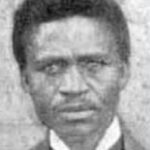KASONGO NYEMBO I
- 4 Min Read
Kasongo Nyembo I, (circa 1860-1931) was the Mulopwe or chief of the Luba state during a period of great political, social, and economic upheaval. In the late 19th century many of Central Africa’s large traditional states were being weakened and fragmented as a new commercial lite, with links to coastal markets and access to modern firearms, gained increasing power.

PHOTO CAPTION: Kasongo Nyembo I. SOURCE: Reddit
In the Luba empire, this process of disintegration was accelerated by an intensification of fratricidal succession wars. Each individual aspiring to the throne had to fight his brothers, nephews, and uncles in a series of battles which escalated in destructiveness as outsiders entered the struggle in hopes of gaining political or commercial rewards.
Kasongo Nyembo, the son of Mulopwe Ilunga Kabale, who died in about 1870, came to power soon after the death of Mulopwe Kasongo Kalombo in about 1885. Succession was not automatic, however, for Kasongo Nyembo had to fight his brothers Dia Mande and Kumi, and also his nephew Kitumba, the son of former Mulopwe Kasongo Kalombo.
Although five pretenders had been killed in battle by 1891, Kasongo Nyembo’s brother Kabongo continued the succession dispute by proclaiming himself as Mulopwe over the northern part of the Luba empire. Because the two brothers had about equal forces, a protracted struggle ensued, in which many local villages became unwillingly involved.
Both Kasongo Nyembo and Kabongo sought to gain allies and aid from any source they could find. Mulowe Kasongo Nyembo maintained contacts with Cokwe (Chokwe) traders from Angola who supplied him with guns and powder, while Kabongo had relations not only with Angolan merchants from Bihé, but also with the agents of Msiri Ngelengwa, from East Africa. In 1891 and 1892, Congo Free State expeditions under Delcommune, Bia, and Francqui passed through the area. By recognising state suzerainty, Kasongo Nyembo gained the favour of these Europeans and achieved a temporary advantage as Delcommune interrupted his journey long enough to make a quick foray against Kasongo’s rival, Kabongo.
In 1896, however, Kabongo received help from Batetela mutineers from the Force Publique (the colonial army). Fleeing their headquarters at Luluabourg (now Kananga) to the Lualaba and Lomami river regions, they sided with Kabongo, forcing Kasongo Nyembo to seek refuge with the Europeans at Kabinda. After a Belgian force under Malfeyt expelled the Batetela from the region in 1901, Kasongo Nyembo returned and in 1902 settled at Lake Samba, 90 km (50 mi) north of Kamina, where the Free State constructed a station in February 1903.
From the start, Kasongo Nyembo’s relations with the Free State were uneasy. Not only did the state agents exact taxes, send soldiers, and insult the Mulopwe’s wives, but they also pursued an ambiguous policy towards the two hostile brothers. Kasongo Nyembo was especially displeased when they established a station at Kabongo’s village near Lake Boya, about 170 km (100 mi) northeast of Kamina. Thus, by 1905, Kasongo Nyembo was engaged in an open revolt against the Congo Free State.
In order to avoid the state agents, Kasongo Nyembo moved first to Lake Samba island and then to a more secure refuge in the bush. When all attempts at peaceful negotiations failed, the state agents organised an unsuccessful police and military expedition to punish the rebellious Mulopwe.
Using their usual policy to divide and conquer, they looked for a rival who could win the loyalty of Kasongo’s people. When this tactic did not succeed, they tried to draw Kabongo into the conflict but he proved hesitant. Finally, in 1911, the government sought to fragment Kasongo Nyembo’s territory by declaring local village chiefs independent from the Mulopwe. The chiefs, however, did not betray the Mulopwe.
The colonial authorities then appealed to troops from Kabinda to subdue Kasongo Nyembo. Making progress towards his refuge, the Kabinda soldiers massacred Luba subjects. Faced with the prospect of even further destruction, Kasongo Nyembo decided to surrender. Thus, in October 1917, the police arrested the Mulopwe in the forest. Afterward, Mulopwe Kasongo Nyembo was transferred to Kabinda, where he was tried and exiled to Buta, 250 km (150 mi) north of what is now Kisangani in northeastern Zaire.
In 1920, when the Belgians attempted to apply the principles of indirect administration, some officials favoured reinstating Kasongo Nyembo. The local administrative authorities, however, opposed his return. Mulopwe Kasongo I therefore remained at Buta until his death from a hernia in 1931.
N’DUA SOLOL KANAMPUMB




